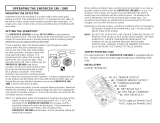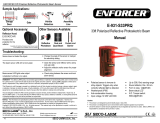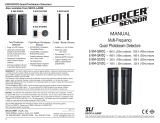Page is loading ...

OPERATING THE ENFORCER 190 / 190S
MOUNTING THE DETECTOR
It therefore should be mounted in a location within which every glass
window and door to be protected is found. For greatest security, attach to
the wall or ceiling, using screws instead of double-sided foam tape. For
larger areas, two or more units can be used without fear of interfering with
each other.
SETTING THE SENSITIVITY
The ENFORCER 190/190S includes SECO-LARM's unique patented
Yellow turbulence LED. This LED flashes when environmental noise is high
enough to cause false alarms, thereby allowing instant sensitivity setting
without the use of a special external test meter.
To set sensitivity, hold a thin flexible plastic ruler flat against a glass
window within the unit's protection range.
Pick up one end of the ruler while holding
the other end down, and then let the ruler
snap against the glass window. This
should cause the Yellow LED to come ON,
but the Red LED should not light. If the
Red LED comes ON with a slight snap, the
ENFORCER 190/190S may be too
sensitive, and the sensitivity control should
be turned counterclockwise with a small
flat or phillips screwdriver. If the Yellow
LED does not come ON, sensitivity should
be increased by turning the control clockwise. Continue snapping the ruler
on the window until the Yellow LED comes ON but the Red LED does not.
Repeat this process with each window to ensure the ENFORCER 190/
190S is set for every pane of glass.
When the correct sensitivity is found using the above procedure, determine
whether the sensitivity is high enough to trigger the alarm by snapping the
ruler harder to simulate a break-in. If the Red LED does not come ON, the
sensitivity must be increased.
NOTE: For applications within this temperature range the sensitivity will be
stable. If the temperature should drop below -14°F (-10°C), the
sensitivity of the ENFORCER 190/190S will increase, and the
sensitivity setting will need to be decreased. If the temperature
should rise above 122°F (50°C), the sensitivity of the
ENFORCER 190/190S will decrease, and the sensitivity setting will
need to be increased.
When setting sensitivity, make sure the room's environment is as close as
possible to what it will be when the ENFORCER 190/190S is in use. For
instance, if the curtains are usually closed at night when the alarm is
armed, then set sensitivity with the curtains closed. If a window in the
room is left opened, then set the sensitivity with window open. The
sensitivity should always be retested when the environment of the room
changes, such as when furniture is moved.
Depending on the type of glass, sensitivity is different when set by tapping
the inside or outside of the window with a ruler. For best results,
tap the inside of the window.
NOTE: DO NOT SET SENSITIVITY ANY HIGHER THAN NECESSARY TO
PROTECT THE GLASS IN THE DETECTOR'S RANGE. SETTING
SENSITIVITY HIGHER THAN NEEDED INCREASES THE
CHANCE OF FALSE ALARMS WITHOUT INCREASING
PROTECTION. LEAVING A DOOR OR WINDOW OPEN WILL
ALSO INCREASE THE CHANCE OF FALSE ALARMS.
TAMPER-PROOFING CASE
For extra protection, the ENFORCER 190/190S is equipped with an
N.C. Tamper Switch to protect against opening or breaking of the
case.
INSTALLATION
SCREW TERMINALS:
MIN MAX
#7: N.C. TAMPER OUTPUT
#6: COMMON TAMPER OUTPUT
#5: COMMON GROUND
#4: 12VDC
#3: DRY RELAY N.O.*
#2: DRY RELAY COMMON*
#1: DRY RELAY N.C.*
* For N.O. output, use Terminals 2 and 3
For N.C. output, use Terminals 2 and 1

INSTALLATION HINTS
1. The ENFORCER 190/190S usually receives power from the alarm
panel. If the ENFORCER 190/190S is connected to a separate power
source, it should also be connected to a rechargeable battery, in case
AC power fails.
2. Use either Terminals 2 and 3 N.O. output or 2 and 1 for N.C. output,
but not both.
3. Close all doors and windows when the ENFORCER 190/190S is in
use.
4. Mount any optional memory buzzer, musical device or any sound
generating equipments as far from the ENFORCER 190/190S as
possible to reduce the detector's chance of accidental triggering, and
reducing the chance of a thief finding the ENFORCER 190/190S.
SPECIFICATIONS
POWER: 12VDC (7.5V - 15V)
CURRENT DRAIN (STANDBY CONDITION): 5mA (12V)
CURRENT DRAIN (TRIGGER CONDITION): 80mA (12V)
DETECTOR OUTPUT: DRY RELAY CONTACT, N.O.-C-N.C. (2A)
TAMPER OUTPUT: N.C. CONTACT
YELLOW LED: INDICATES ENVIRONMENTAL NOISE LEVEL
RED LED: INDICATES TRIGGER SIGNAL SENT TO ALARM
TEMPERATURE RANGE: -14°F TO +122°F (-10°C TO +50°C)
CASE CONSTRUCTION: ABS PLASTIC
SIZE: 4.5" x 2.8" x 1.1" (115mm x 70mm x 27mm)
WEIGHT: 3.35oz (95g)
USA PAT. 4700332
UK PAT. 2177797
1041888
TAIWAN PAT.50612
The SECO-LARM policy is one of continual developments and improvements.
For this reason, SECO-LARM reserves the right to change specifications without further notice.
REMARKABLE FEATURES
l YELLOW TURBULENCE LED (PATENTED) ALLOWS FAST AND EASY
SENSITIVITY ADJUSTMENT WITHOUT EXTERNAL TEST METER
l YELLOW LED GIVES PINPOINT SENSITIVITY ADJUSTMENT TO ELIMINATE
FALSE ALARMS
l DETECTS THE HIGH-FREQUENCY SOUND OF GLASS BREAKING
l ENFORCER 190 -- WIDE 25' RADIUS PROTECTION AREA IF
CEILING-MOUNTED, 45' IF WALL-MOUNTED
ENFORCER 190S -- WIDE 20' RADIUS PROTECTION AREA IF
CEILING-MOUNTED, 35' IF WALL-MOUNTED
l RED TRIGGER LED
l TAMPER PROOF CASE
l INSTALLS WITHOUT RF-SHIELDED CABLE
l COMPACT SIZE AND ATTRACTIVE APPEARANCE ALLOWS INSTALLATION
ANYWHERE
HOW IT WORKS
The ENFORCER 190/190S is the most convenient audio-discriminator for glass break
protection on the market today. Designed with the latest technology, it is the installer's
answer to the problem of sensitivity setting and false alarms. A single convenient
ENFORCER 190/190S is enough to protect all the windows and doors within a 15'
radius when mounted on the ceiling, eliminating the need to install unsightly individual
detectors on each pane of glass. Sensitivity setting is extremely simple with
SECO-LARM's Yellow turbulence LED (patented) which eliminates the need for
external test meters. The relay output is programmed for a 2-second reset.
FILE: MI190.P65/MU/DEC1997
ORDER PART# 760-362-1/86C
SECO-LARM
ENFORCER
190/190S
GLASS BREAK DETECTOR
ALARM SYSTEMS AND ACCESSORIESALARM SYSTEMS AND ACCESSORIES
ALARM SYSTEMS AND ACCESSORIESALARM SYSTEMS AND ACCESSORIES
ALARM SYSTEMS AND ACCESSORIES
Copyright 1997 SECO-LARM U.S.A., INC. ALL RIGHTS RESERVED.
ENFORCER
®
IS A REGISTERED TRADEMARK OF SECO-LARM
®
SECO-LARM
U.S.A., INC.
17811 Sky Park Circle, Suite D & E,
Irvine, CA 92614
SECO-LARM
Telephone
(800) 662-0800
(714) 261-2999
Fax
(714) 261-7326
/






